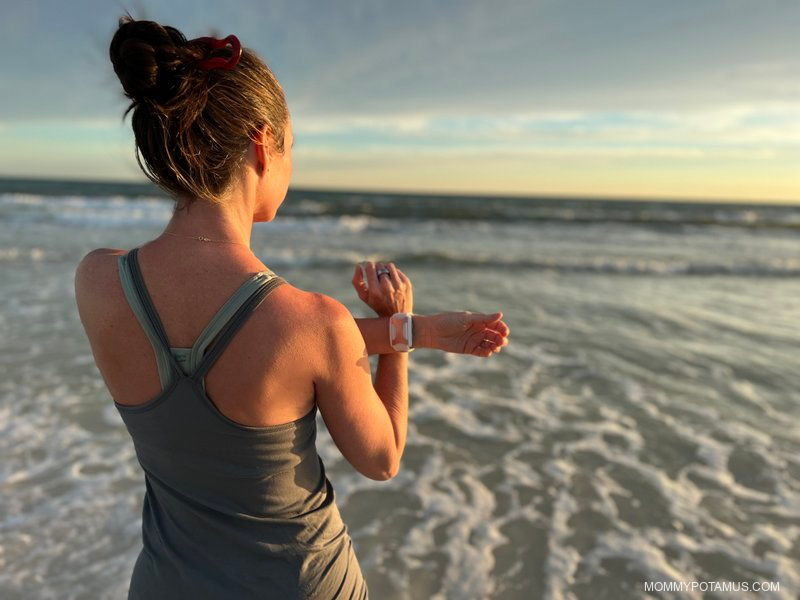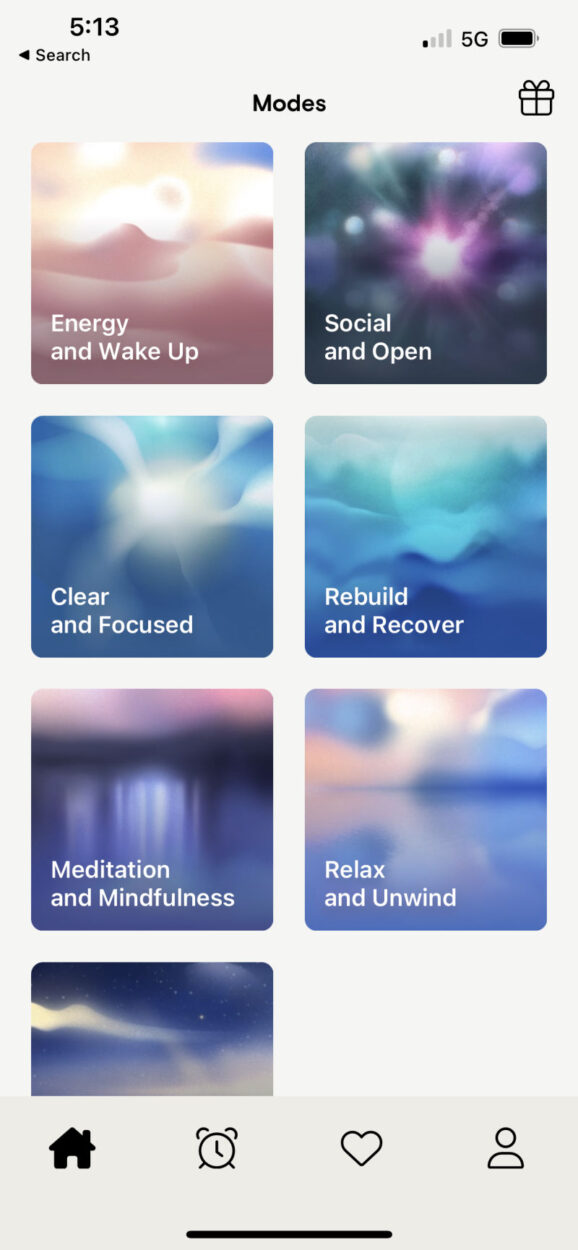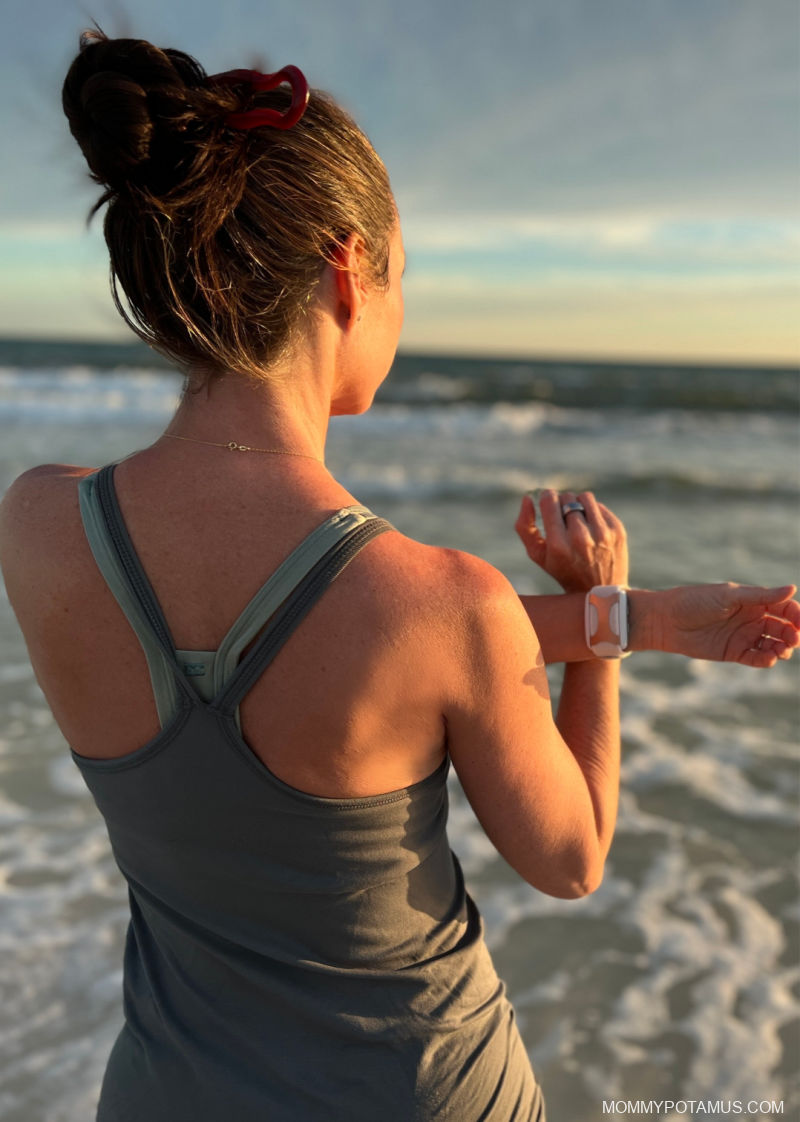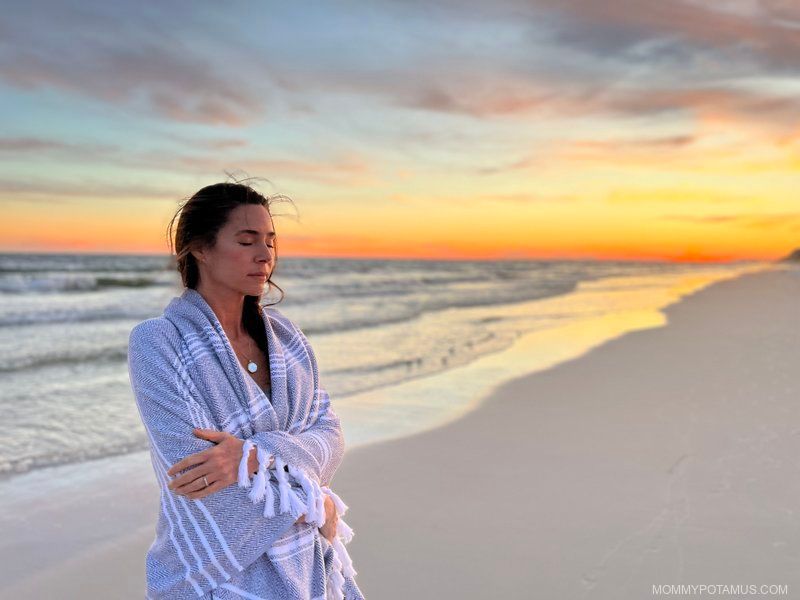
Tell me if this sounds familiar: Your to-do list just keeps growing, the list of things you’d actually like to be doing is mostly collecting dust, and you’re constantly bombarded with notifications, emotional stressors, physical stressors like artificial blue light and EMFs, and more.
Modern life is intense, and research indicates that it’s spiking stress and anxiety levels across the board – in children, teens and adults. (1)(2)(3)
We know that chronic stress is seriously bad for us, and it’s important to take intentional action to lower our levels. There are tons of different ways to do that – breath work, cold plunges, exercise, and gratitude journaling, to name a few. As you might have guessed, the Apollo Neuro can help dial down stress levels, too.
Unlike wellness wearables that track biometrics like sleep efficiency and heart rate variability (HRV), the Apollo Neuro actively aims to improve them. Created by neuroscientist, psychiatrist, and Apollo Neuroscience co-founder Dr. David Rabin MD, PhD., its technology originates from Rabin’s work at the University of Pittsburgh along with decades of scientific research into vibration frequencies and how they impact the body.
Seven clinical trials have found it to be helpful for improving a variety of metrics – including HRV, sleep, focus, and recovery – and there are fourteen more underway. We’ll dive into those below, along with my personal experience using it.
As always, none of these statements have been evaluated by the FDA, this article is not medical advice, and it’s not meant to diagnose or treat any condition. Now that we’ve got that out of the way, let’s dive in . . .

What is Apollo Neuro?
The Short Version : It’s a wearable device that uses subtle vibrations (haptic feedback) to help our brain and body feel safe, resulting in benefits like reduced stress levels, better sleep, and improved focus. It can be worn like a bracelet around the wrist or ankle, and it also comes with a clip that can be attached to a waistband or bra strap.
The Sciency Version: You already know that your autonomic nervous system has two sides – the sympathetic (fight or flight response) and the parasympathetic (rest and repair).
One branch is not necessarily better than the other – it’s the sympathetic side that motivates us to get out of bed and/or exercise, and it’s the parasympathetic side that helps us relax, unwind, and make deep emotional connections that support overall wellness.
Actually, because both sides can be helpful depending on the situation, our ability to switch between modes is considered a major indicator of overall wellness. One way to indirectly measure how adaptable your nervous system is through a metric called heart rate variability.
Basically, your heart is hardwired to both sides of your nervous system via the sinoatrial node, and it receives messages constantly.
When our sympathetic side is doing the talking our heart speeds up,and when our parasympathetic side is talking it slows down. So, when the heart is having good communication with both sides, you’ll see slight variations in the time between heartbeats. That, in a nutshell, is heart rate variability.
I’ve written in more detail about HRV in this article – including how to track it with a $10 app and your phone – plus how to improve HRV in this article. In general, though:
- High HRV (lots of fluctuations due to communication from both sides) is associated with better physical and mental health. (4) It’s an indicator that your autonomic nervous system is balanced, adaptable, and capable of responding to the environment/new situations effectively.
- Low HRV (fewer fluctuations because one side is dominating) may be an indicator that your body is overtaxed in some way – dehydration, exhaustion, stress or illness, for example.
When HRV is low, it’s typically because our sympathetic (fight or flight) side is “shouting over” our parasympathetic side. Using a form of touch therapy that creator Dr. Rabin once described it as a “wearable hug for your nervous system,” the Apollo Neuro helps balance the sympathetic/parasympathetic response.
Not surprisingly, “gold standard” double-blind randomized placebo controlled crossover trials have found it to be helpful for improve HRV along with other metrics of well-being like sleep quality. We’ll dive into some of the study highlights below.
How It Works
The Apollo has seven different modes that can be selected via a free app, which is available for Apple and Android phones. If you’re like me and don’t want any bluetooth-emitting devices on your body, you’ll be happy to know that you can easily switch it to airplane mode during use.
Each mode can be chosen in real-time, or you can schedule sessions to start automatically throughout the day. Each day can be scheduled identically, or you can create different schedules for different days of the week. (So, for example, your weekend schedule could be different from your weekday schedule).
Mine is on a schedule so I pretty much wear it all the time (unless I’m charging it, in the sauna, etc.) and almost never manually start a session.
For example, my Apollo automatically starts an Energy and Wake Up session at 7:30 am, which is when I head outside for my morning yoga session. I have several other sessions programmed throughout the day, which wraps up with a 2 hour Sleep and Renew session at 10pm.
The intensity of each session can be adjusted, and so can the amount of time each one lasts (anywhere from 15 minutes to 2 hours depending on the mode). Also, there’s a playback feature that allows you to automatically repeat the last session just by pressing two buttons on the Apollo. I love it because if the REALLY LOUD FROG that currently lives on my back porch wakes me up at 5am, I can restart my Sleep and Renew session and get back to sleep fairly quickly.
Important note: Just like working out and eating healthy, consistency is key. Or as Apollo Neuroscience puts it, “The more you use it, the better it works.” They recommend 3+ hours a day, 5+ days per week. Because it’s so easy to “set and forget” with the scheduling option, I use mine for 3+ hours every single day.

Here are the available modes along with the descriptions found in the Apollo app . . . and some comments from me:
Energy and Wake Up – Gives you a boost of energy when you’re feeling tired or sluggish. Other uses: Boring meetings, to feel alert, when seeking espresso. (I love how this one helps me feel ready to take on the day.)
Clear and Focused – Filters out distraction and settles your nerves for clear, calm focus. Other uses: Pre-athletic performance, presentations, productivity, to relieve headache or mild nausea. (I have this one scheduled on repeat throughout the morning.)
Social and Open – Elevates mood and energy to relieve stress in social situations, whether at work or play. Other uses: Networking, parties, date night, creative work.
Rebuild and Recover – Accelerates your body’s recovery after a workout. Other uses: after mental or physical stress, when feeling run down or sick, after long flights or travel.
Meditation and Mindfulness – Prepares you for meditation by facilitating the connection between body and mind. Other uses: For calm flow states, when feeling tense or sore/achy, a dose of zen (even when you can’t meditate). (I use this one midday, often while I’m doing a 15-30 minute breathwork session on my deck. Sometimes I fall asleep for a few minutes and sometimes I don’t, but either way I feel refreshed and ready to take on the second half of the day when I’m done.)
Relax and Unwind – Rapidly relieves stress for deep relaxation. Other uses: Deep relaxation before bed, for relaxation during travel, to calm down after intense stress.
Sleep and Renew – Quiets your mind and eases you into restful sleep. Other uses: Before and during sleep, to fall asleep during the night. (It’s hard to pick a favorite, but it’s probably this one and Energy and Wake Up. Basically, my whole day goes better when I start and end with these sessions.)
My Schedule
In case you’re curious, here’s how my personal schedule is organized. It took me less than five minutes to set up via the app.
- 7:30 am – Energy and Wake Up + Morning yoga session outside
- 9:00 am – Clear and Focused + First cup of CGA-rich coffee
- 11:00 am – Clear and Focused (Again, because life)
- 1:00 pm – Meditation and Mindfulness + Breathwork outside
- Afternoon – Charge Apollo
- 7:00 pm – Relax and Unwind + Family time
- 10:00 pm – Sleep and Renew + Bed
Sometimes I Add:
- Social and Open
- Rebuild and Recover
Apollo Neuroscience Research
Seven clinical trials have been completed so far – two of which are “gold standard” double-blind randomized placebo controlled crossover trials – and there are fourteen more studies underway. You can find a detailed overview on this page, but here are some of the highlights:
Deeper, Longer Sleep + Higher HRV
In one clinical trial, 550+ people wore an Apollo Neuro and an Oura ring in order to track the Apollo’s effects in a real-world environment. After collecting baseline metrics via the Oura ring for an average of five months per participant, the volunteers began using the Apollo for 3+ hours per day, 5+ days per week. The study is ongoing, however preliminary results after tracking users for 3-15 months (depending on when they entered the study) show some impressive improvements, including:
- 19% average increase in deep sleep
- 14% average increase in REM sleep
- 11% average increase in HRV
- Up to 30 more minutes of sleep a night
- Improved cardiovascular metrics
Increased Cognitive Performance + HRV
In a double-blind randomized placebo-controlled crossover clinical trial conducted at the University of Pittsburgh, Apollo vibrations improved heart rate variability (HRV) and cognitive performance when participants were asked to complete a stressful task.
Workout Recovery + Higher HRV
One double-blind randomized placebo-controlled crossover trial conducted by the University of Pittsburgh found that the Apollo neuro improved heart rate variability and recovery time for athletes. (5)

My Experience With The Apollo Neuro
Trauma can come in many forms, often with effects we don’t recognize as trauma. For me, both emotional trauma (like the loss of my dad to cancer when I was eleven) and physical trauma (like Lyme disease, which can cause changes in the brain similar to traumatic brain injuries) led to instability in my nervous system – specifically a tendency toward sympathetic overdrive (fight, flight, or freeze).
Just like spraining an ankle may make it more vulnerable to future injuries if it doesn’t heal correctly, my understanding is that past traumas affecting the nervous system may make it more prone to dysfunction in the present. That’s my theory about why I’m seriously prone to getting stuck in fight or flight mode.
So, as part of my healing journey, I’ve made stabilizing my nervous system a top priority through consistent self-care practices like:
- Morning yoga in the sun
- Breathwork
- Liberal use of adaptogens (herbs that support stress resilience) and nervines (calming herbs)
When my nervous system is balanced (as measured via HRV), I feel more present in my life – thoroughly enjoying time with my people, taking in the world around me, sleeping deeply, exploring new places and ideas, and more.
Unfortunately, it takes a lot of consistent effort, and I have real-life responsibilities that limit how much time I can work on balancing my nervous system. That’s the first thing that drew me to the Apollo – unlike other devices that would require me to set aside more time for focused sessions, the Apollo can just go with me throughout my day.
It was an investment, but because I’d had the opportunity to test one out for several months in 2020 I knew it would probably be worth it.
Here are my thoughts after using it for 3+ hours, 7 days per week for awhile:
- It’s not a magic button – or in this case, bracelet – but I have definitely noticed a difference both subjectively (feelings of well-being) and objectively (via biometrics measured by my Oura ring)
- My HRV score is more stable (fewer dramatic drops when stressful things happen) and it’s generally trending upwards. As the weather warms up I’m also spending more time outside, so that’s helping my HRV too.
- I feel more relaxed and productive throughout the day.
- It works best when combined with other wellness practices (walking, yoga, breathwork, prioritizing sleep, etc.). Weirdly, I’ve found that when I’m wearing the Apollo I want to do those things more. Before Apollo I would make myself despite feeling internal resistance.
- As I learn to regulate my own nervous system, I’m better able to help my kids do the same. Today more than ever, it’s a basic life skill we all need.
Pros
- Clinically validated to improve HRV, cognitive performance and sleep
- Easy to incorporate into my day – No dedicated time required
- Comfortable and convenient – Can be worn on different areas of the body
- Adjustable vibration intensity and session time
- Enjoyable – The low-frequency pulses remind me of a purring cat or the gentle vibrations that lull me to sleep on long car rides (when my husband is driving)
- Can be easily switched into airplane mode during use
- Help getting back to sleep when needed – I can reactivate “Sleep and Renew” mode if I wake up in the middle of the night just by pressing a couple of buttons (airplane mode is still on)
- Quiet vibrations (Inaudible to you and anyone around you unless you hold it right to your ear)
- Can be paired with the Apple Health app and Oura ring (If you connect with Apple Health, your Apollo minutes will count as your Mindful Minutes. If you connect with Oura you can participate in the ongoing sleep study.)
- One time cost – Unlike some wearables, there’s no subscription fee to use the app. Your only cost is the actual device.
Cons
- Battery life – Some users only need to charge every few days, but I use mine so often (at max intensity) that I have to charge it daily. Although I’d prefer for the battery to last longer, it’s not really a big deal to recharge it in the late afternoon when I don’t have any sessions scheduled.
- Price – It’s an investment (see discount info below)
- Ankle bracelet option may get you some funny looks – I sometimes wear the Apollo on my ankle at home, but it kind of looks like a court-ordered ankle monitor so I put it on my wrist or under jeans when I’m out. It can also be clipped near the chest or waist. I recommend making sure bluetooth is off.
- Cleaning – If you get one of darker models you should be fine, but I opted for the white band with the rose accent. I spend a lot of time doing stuff outside so the band gets dirty often. Instead of cleaning it and skipping a session while the band dries, I bought a second band to swap out as needed. Apollo says to clean the bands with alcohol, but mine needs soap and water. It’s made with neoprene and polyester and has held up well to gentle hand washing so far.
- Water resistant but not waterproof – Don’t wear it in the shower, while swimming or during strenuous exercise.
Final Thoughts + How To Save 10%
Research shows that exercising with a friend increases consistency, which ultimately leads to better fitness. (6) There are probably a lot of reasons for this, including built-in accountability and social fulfillment.
For me, the Apollo kind of feels like a “friend” to my nervous system that makes it easier for me to be consistent in my other wellness practices. In the past, when I’d get stuck in fight or flight, I’d often put off self-care because I just wanted to “take care of this one last thing” which always turned into ten.
Now, if I’m in that mode when an Apollo session starts, I recalibrate fairly quickly and realize those ten things can wait. Also, I’m getting stuck in fight or flight less often.
Are there free ways to build nervous system resilience? Absolutely! I’m working as many into my day as I can. However, as someone who has a strong tendency toward sympathetic dominance I’ve found the Apollo to be a worthwhile investment.
To try out the Apollo Neuro, click here and use code MP10 to save 10%
Sources
- Georgetown University (2022) Research Update: Children’s Anxiety and Depression on the Rise
- Jean M Twenge et. al. (2010) Birth cohort increases in psychopathology among young Americans, 1938-2007: A cross-temporal meta-analysis of the MMPI
- Renee D Goodwin et. al. (2020) Trends in anxiety among adults in the United States, 2008-2018: Rapid increases among young adults
- Adrian L Lopresti (2020) Association between Micronutrients and Heart Rate Variability: A Review of Human Studies
- Cameron Hallihan and Greg J. Siegle (2022) Effect of vibroacoustic stimulation on athletes recovering from exercise
- Insider (2020) A Harvard researcher says working out with friends is the best way to meet your goals




